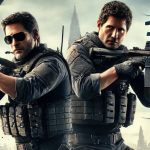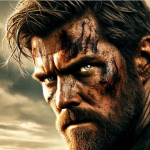𝙎𝙣𝙤𝙬𝙥𝙞𝙚𝙧𝙘𝙚𝙧 (𝟮𝟬𝟭𝟰)

Snowpiercer Official US Release Trailer #1 (2014) – Chris Evans Movie HD
Snowpiercer (2014), directed by Bong Joon-ho, is a visually striking, intense dystopian thriller that takes place in a world gripped by a new Ice Age. This international production, starring Chris Evans, Tilda Swinton, and Song Kang-ho, is set entirely aboard a massive train perpetually circling the globe. Known for its blend of social commentary and gripping action, Snowpiercer explores themes of class division, survival, and rebellion in a post-apocalyptic society.
Plot Summary
In the year 2031, Earth has become an uninhabitable frozen wasteland after a failed attempt to stop global warming plunged the planet into an ice age. The only remnants of humanity now survive aboard the Snowpiercer, a powerful train that never stops, constantly traveling across the globe. Inside, society is strictly divided by class. The wealthy elite enjoy luxuries in the front cars, while the impoverished, exploited lower class is confined to squalid conditions in the tail section.
Curtis (Chris Evans), a reluctant leader among the oppressed, decides that the only way to survive is to lead a revolt. He, along with his allies including Edgar (Jamie Bell), Tanya (Octavia Spencer), and Gilliam (John Hurt), plans an uprising to reach the engine at the front of the train, which represents both power and control. Along the way, they encounter surreal carriages, each representing a different facet of the privileged lifestyle. As Curtis and his team push forward, they face armed guards, psychological obstacles, and revelations that challenge their beliefs about the nature of power and humanity.Themes and Social Commentary

Snowpiercer is rich with social commentary, exploring issues of class inequality, oppression, and the illusion of progress. The train’s rigid class hierarchy serves as a metaphor for societal stratification, with the upper class sustaining their comfortable existence at the expense of the lower class. Each section of the train reflects a different aspect of society—from resource scarcity in the back to the indulgent excess in the front. This stark division raises questions about morality, survival, and the costs of privilege.
Curtis’s journey represents the struggle to break free from a system that systematically suppresses the lower class. As the group advances toward the engine, they come to realize that the hierarchy is not simply a physical structure but a deeply ingrained system of control. The film criticizes the cyclical nature of such systems, illustrating how the quest for power can lead to moral compromises.
Visuals and Direction
Bong Joon-ho’s direction is both inventive and meticulous. Despite the confined setting, each carriage is visually distinct, and the film uses lighting, color, and set design to convey the disparities between classes. Bong balances brutal action with surreal, dark humor, creating an experience that is as thought-provoking as it is visually engaging. The camera work, paired with expertly choreographed action scenes, brings an intense, claustrophobic feel, especially during close-quarters combat sequences.
The film’s unique, confined setting aboard the train enhances the sense of urgency and tension. Bong Joon-ho skillfully paces the narrative, making each new car an opportunity for deeper insight into the lives and mindsets of the train’s inhabitants. The progression from the grimy tail section to the opulent front cars is like peeling away layers of society’s facade, with each car serving as both a setting and symbol of the systems of control and complacency.
Performances
Chris Evans delivers one of his most intense performances as Curtis, bringing depth to a character who wrestles with guilt, leadership, and sacrifice. Evans portrays Curtis as both fierce and deeply conflicted, capturing the weight of his decisions as he leads his comrades through danger and moral ambiguity.
Tilda Swinton stands out as Mason, a grotesque, almost absurdist caricature of the privileged elite, who is both menacing and darkly comical. Her mannerisms and speech capture the twisted logic and cruelty of the ruling class, adding an extra layer of menace to the antagonists. Song Kang-ho, as the enigmatic security specialist Namgoong Minsu, brings complexity and humor, illustrating his character’s own motivations and beliefs about freedom and survival.
Reception and Legacy
Snowpiercer received widespread critical acclaim, praised for its unique premise, direction, and thematic depth. Bong Joon-ho’s approach to storytelling—mixing elements of action, thriller, and social allegory—resonated with audiences and critics alike. The film’s blend of thought-provoking content and visceral action helped it become a cult classic and solidified Bong’s international reputation.
Following the film’s success, Snowpiercer was adapted into a television series in 2020, exploring the same themes with additional narrative depth. The story’s resonance has continued, with the film often cited as an insightful critique of class division and environmental collapse, themes that have only grown more relevant.
Conclusion
Snowpiercer is a bold, innovative film that uses a simple concept—survival aboard a train—as a powerful metaphor for class conflict and social inequality. With Bong Joon-ho’s masterful direction, a compelling cast, and a gripping, socially conscious narrative, Snowpiercer remains a landmark in dystopian cinema. It challenges viewers to question systems of power and reminds us that the cost of social hierarchies is often paid by those left at the back.











